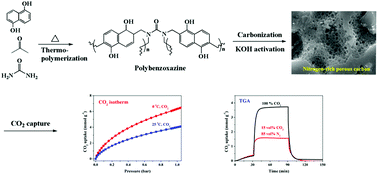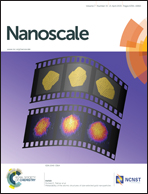Synthesis of polybenzoxazine based nitrogen-rich porous carbons for carbon dioxide capture†
Abstract
Nitrogen-rich porous carbons (NPCs) were synthesized from 1,5-dihydroxynaphthalene, urea, and formaldehyde based on benzoxazine chemistry by a soft-templating method with KOH chemical activation. They possess high surface areas of 856.8–1257.8 m2 g−1, a large pore volume of 0.15–0.65 cm3 g−1, tunable pore structure, high nitrogen content (5.21–5.32 wt%), and high char yields. The amount of the soft-templating agent F127 has multiple influences on the textural and chemical properties of the carbons, affecting the surface area and pore structure, impacting the compositions of nitrogen species and resulting in an improvement of the CO2 capture performance. At 1 bar, high CO2 uptake of 4.02 and 6.35 mmol g−1 at 25 and 0 °C was achieved for the sample NPC-2 with a molar ratio of F127 : urea = 0.010 : 1. This can be attributed to its well-developed micropore structure and abundant pyridinic nitrogen, pyrrolic nitrogen and pyridonic nitrogen functionalities. The sample NPC-2 also exhibits a remarkable selectivity for CO2/N2 separation and a fast adsorption/desorption rate and can be easily regenerated. This suggests that the polybenzoxazine-based NPCs are desirable for CO2 capture because of possessing a high micropore surface area, a large micropore volume, appropriate pore size distribution, and a large number of basic nitrogen functionalities.


 Please wait while we load your content...
Please wait while we load your content...